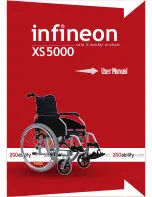
User Manual Multitec
15
Drive Medical GmbH & Co. KG | As per: 13.03.2018 | Subject to error and change
EN
Getting over stairs:
Since it is difficult to get over stairs, we recommend
getting assistance from two attendants, one in front of
the wheelchair and one behind the wheelchair.
The attendant positioned behind the wheelchair tilts it
until it is balanced. Then he/she holds it against the first
stair, gripping the handle firmly to help lift the wheelchair.
The attendant who is positioned in front of the wheelchair
holds the front lateral frame firmly and lifts the chair over
the stairs while the other person places one foot on the
next stair and repeats the first step.
Do not lower the steering wheels of the wheelchair until
the attendant positioned in front of the wheelchair has
crossed the last stair.
To go down stairs, the same procedure as described
above should be followed, in reverse order.
Do not attempt to lift the wheelchair by grasping
any removable parts (for example, the armrests, leg
supports or foot supports).
Avoid using an escalator.
TRAVELING ON INCLINES
We recommend avoiding ramps with an incline of more
than 9°. In the case of larger inclines, there is a risk of
tipping over if the wheels spin or when approaching an
incline at an oblique angle.
Going up ramps:
Lean your upper body forward and operate the hand
rims with rapid pushes to reach the proper speed. If you
want to stop to rest along the way, the two brakes must
be operated simultaneously.
Going down ramps:
Lean your upper body backwards and let the hand rims
slide through your hands, ensuring that you can control
the speed and direction.
Avoid sudden direction changes, never attempt to
ascend or descend a ramp diagonally, and do not
attempt to turn the wheelchair when ascending
The wheelchair is not suitable as a seat for driving a
vehicle.
HEATING IN THE SUN OR NEAR HEATING ELEMENTS
The wheelchair must not be continuously exposed to
temperatures over + 40°C. Otherwise the parts of the
frame and the seat, backrest and armrests may heat up,
which could lead to burns.
• Secure the parking brakes of the rear wheels.
• During the transfer, there will be little or no support
underneath you; use a transfer board, if at all possible.
• If you are able to stand more or less upright and if you
have sufficient upper body strength and mobility, you
can transfer yourself forwards to another seat. Fold up
the foot plate and push the foot support/leg support
to the side to clear the way, bend your body forwards
while you support yourself on the two armrests and
stand up. Then push your body in the direction of the
place where you wish to sit while distributing your
weight on your arms and hands.
FORWARD TRANSFER
If this movement is difficult for you, we recommend
obtaining assistance from an attendant or caregiver to
ensure a transfer that is as easy and safe as possible.
Secure both brakes and ensure that both steering
wheels are pointing forwards. In doing so, be aware
that you should not under any circumstances support
yourself on the brakes during the transfer.
Then grasp the top of the armrests, support yourself on
your arms in order to easily get up and the attendant can
assist you in completing the transfer.
• Position yourself as near as possible to the place
where you wish to sit.
• During the transfer, position yourself as far back in the
seat as possible to prevent the seat cushion from being
damaged or the wheelchair from tipping forward.
• Secure the two brakes; they should always be used as
support for transfers.
• Never support yourself on the foot supports when
sitting or getting up from the wheelchair.
TILTING, OVERCOMING OBSTACLES, SUCH AS
CURBS
Getting up onto the sidewalk:
The attendant positions the wheelchair in forward gear
in front of the sidewalk. He/she then tilts the wheelchair
backwards until the steering wheels reach up onto the
sidewalk; he/she pushes the wheelchair forward until
the rear wheels are against the edge of the curb and
pushes the wheelchair once again until the rear wheels
roll over the edge of the curb.
Operating the tilt aid:
To maneuver around curbstones and over thresholds
step firmly (with the left or right foot) on the tilt aid while
simultaneously pushing down the handles. This ensures
that lifting the front of the wheelchair is easier. Ensure
that you are standing securely.
Getting down off the sidewalk:
The attendant positions the wheelchair facing forward
with the back to the sidewalk and tilts it backwards
until it is balanced. Then he/she pushes the wheelchair
forward until the rear wheels touch the street, after it has
driven over the obstacle. Then he/she gradually lowers
the steering wheels to the ground.
















































